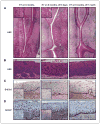Persistence of high-grade cervical dysplasia and cervical cancer requires the continuous expression of the human papillomavirus type 16 E7 oncogene
- PMID: 19435895
- PMCID: PMC3006677
- DOI: 10.1158/0008-5472.CAN-09-0023
Persistence of high-grade cervical dysplasia and cervical cancer requires the continuous expression of the human papillomavirus type 16 E7 oncogene
Abstract
Several mucosotropic human papillomaviruses (HPV), including HPV type 16 (HPV-16), are etiologic agents of a subset of anogenital cancers and head and neck squamous cell carcinomas. In mice, HPV-16 E7 is the most potent of the papillomaviral oncogenes in the development of cervical disease. Furthermore, interfering specifically with the expression of E7 in HPV-positive cell lines derived from human cervical cancers inhibits their ability to proliferate, indicating that the expression of E7 is important in maintaining the transformed phenotype in vitro. To assess the temporal role of E7 in maintaining HPV-associated tumors and precancerous lesions in vivo, we generated Bi-L E7 transgenic mice that harbor a tetracycline-inducible transgene that expresses both HPV-16 E7 and firefly luciferase. When we crossed Bi-L E7 mice to a K5-tTA transgene-inducing line of mice, which expresses a tetracycline-responsive transactivator selectively in the stratified squamous epithelia, the resulting Bi-L E7/K5-tTA bitransgenic mice expressed E7 and luciferase in the skin and cervical epithelium, and doxycycline repressed this expression. Bitransgenic mice displayed several overt and acute epithelial phenotypes previously shown to be associated with the expression of E7, and these phenotypes were reversed on treatment with doxycycline. Repressing the expression of E7 caused the regression of high-grade cervical dysplasia and established cervical tumors, indicating that they depend on the continuous expression of E7 for their persistence. These results suggest that E7 is a relevant target not only for anticancer therapy but also for the treatment of HPV-positive dysplastic cervical lesions.
Conflict of interest statement
No potential conflicts of interest were disclosed.
Figures




References
-
- zur Hausen H. Papillomaviruses and cancer: from basic studies to clinical application. Nat Rev Cancer. 2002;2:342–50. - PubMed
-
- Bosch FX, Manos MM, Munoz N, et al. Prevalence of human papillomavirus in cervical cancer: a worldwide perspective. International Biological Study on Cervical Cancer (IBSCC) Study Group. J Natl Cancer Inst. 1995;87:796–802. - PubMed
-
- Leechanachai P, Banks L, Moreau F, Matlashewski G. The E5 gene from human papillomavirus type 16 is an oncogene which enhances growth factor-mediated signal transduction to the nucleus. Oncogene. 1992;7:19–25. - PubMed
Publication types
MeSH terms
Substances
Grants and funding
LinkOut - more resources
Full Text Sources
Medical
Molecular Biology Databases
Research Materials

